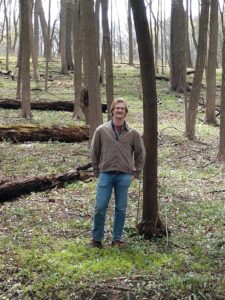Lucien Fitzpatrick
Ph.D. Student, Department of Ecology, Evolution, and Natural Resources, Rutgers University
 BA, Biology, Oberlin College
BA, Biology, Oberlin College
As someone who grew up exploring nature in the urban parks and forests of Chicago, I have always been fascinated with intertwining nature and trees into urbanized environments. I am particularly interested in understanding how different dimensions of forest diversity (taxonomic, structural, functional, phylogenetic) impact ecosystem functioning and services in urban forests so that practitioners can promote healthy forests that provide the services we plant them for, such as heat amelioration, carbon storage, and fauna biodiversity.
Research goal: Evaluating the role of forest structural diversity on ecosystem functioning and service provisioning in urban forests.
Current project: Examining the relationship between forest structure diversity and ecosystem functions at the FRAME urban forest patches.
Biodiversity is known to increase the ecosystem functioning of a wide variety of ecosystems, but biodiversity can be quantified many different ways (taxonomic, functional, phylogenetic) but one dimension of diversity often excluded from analysis is structural diversity. Structural diversity captures the diversity of vegetative structures contained within a forest patch and reflects the 3D arrangement of vegetation within space. Forest structure plays a role in key ecosystem processes such as water use and light availability and so characterizing its influence alongside more traditional metrics of biodiversity is key to understanding how to improve the health and functioning of forest patches. This information is also of particular importance for urban forest patches as they are directly managed for the services they provide and have a wide variety of structural diversity. I will be characterizing the structural diversity of the FoRests Among Managed Ecosystem (FRAME) urban forest patches alongside traditional measurements of biodiversity and measures of ecosystem functioning to evaluate the relationship between structural diversity and ecosystem functioning.
PUBLICATIONS
- L. Fitzpatrick, P.J. Giambuzzi, A. Spreitzer, B. Reidy, S.M. Still, C.R. Rollinson, “Improving phenology predictions for sparsely observed species through fusion of botanical collections and citizen-science”, Climate Change Ecology. 2 (2021) 100032.
- R. Dybzinski, E. Segal, M. L. McCormack, C. R. Rollinson, R. Mascarenhas, P. Giambuzzi, J. Rivera, L. Fitzpatrick, C. Wiggins, M Midgley “Calculating nitrogen uptake rates in forests: which components can be omitted, simplified, or taken from trait databases and which must be measured in situ?”
- L. Fitzpatrick, C.R. Rollinson, A.R. Desai, B.A, Murphy, K. Dreisilker, M. Midgley, “Management Legacies Interactions with Forest Structure Influence Forest Biomass Responses to Climatic Increases in Atmospheric Water Vapor Demand.” In revision at Ecological Applications
CV
